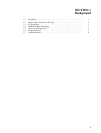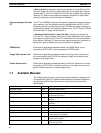
3
Actually there is not a total equivalence between these terms, because the
term condition is used only to describe ladder diagram programs in general
and is specifically equivalent to one of certain basic instructions. The terms
input and output are not used in programming per se, except in reference to
I/O bits that are assigned to input and output signals coming into and leaving
the PC. Normally open conditions and normally closed conditions are ex-
plained in
4-3 The Ladder Diagram
.
1-3 PC Terminology
Although also provided in the
Glossary
at the back of this manual, the follow-
ing terms are crucial to understanding PC operation and are thus explained
here as well.
When we refer to the PC, we are generally talking about the CPU and all of
the Units directly controlled by it through the program. This does not include
the I/O devices connected to PC inputs and outputs.
If you are not familiar with the terms used above to describe a PC, refer to
Section 2 Hardware Considerations
for explanations.
A device connected to the PC that sends a signal to the PC is called an input
device; the signal it sends is called an input signal. A signal enters the PC
through terminals or through pins on a connector on a Unit. The place where
a signal enters the PC is called an input point. This input point is allocated a
location in memory that reflects its status, i.e., either ON or OFF. This mem-
ory location is called an input bit. The CPU in its normal processing cycle
monitors the status of all input points and turns ON and OFF corresponding
input bits accordingly.
There are also output bits in memory that are allocated to output points on
Units through which output signals are sent to output devices, i.e., an out-
put bit is turned ON to send a signal to an output device through an output
point. The CPU periodically turns output points ON and OFF according to the
status of the output bits.
These terms are used when describing different aspects of PC operation.
When programming, one is concerned with what information is held in mem-
ory, and so I/O bits are referred to. When describing the Units that connect
the PC to the controlled system and the places on these Units where signals
enter and leave the PC, I/O points are referred to. When wiring these I/O
points, the physical counterparts of the I/O points, either terminals or connec-
tor pins, are referred to. When describing the signals that enter or leave the
system, reference is made to input signals and output signals, or sometimes
just inputs and outputs.
The Control System includes the PC and all I/O devices it uses to control an
external system. A sensor that provides information to achieve control is an
input device that is clearly part of the Control System. The controlled system
is the external system that is being controlled by the PC program through
these I/O devices. I/O devices can sometimes be considered part of the con-
trolled system, e.g., a motor used to drive a conveyor belt.
1-4 OMRON Product Terminology
OMRON products are divided into several functional groups that have ge-
neric names.
Appendix A Standard Models
list products by these groups.
The term Unit is used to refer to all OMRON PC products, depending on the
context.
The largest group of OMRON products is I/O Units. I/O Units come in a vari-
ety of point quantities and specifications.
PC
Inputs and Outputs
Controlled System and
Control System
OMRON Product Terminology Section 1-4


















